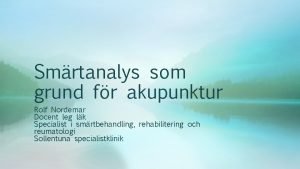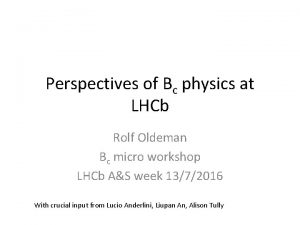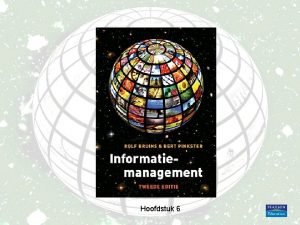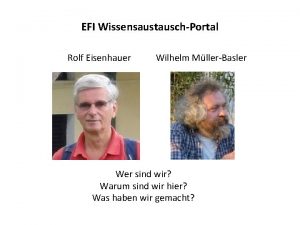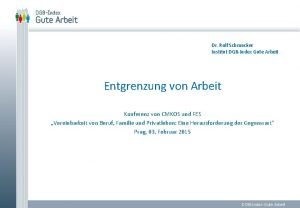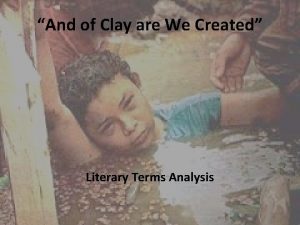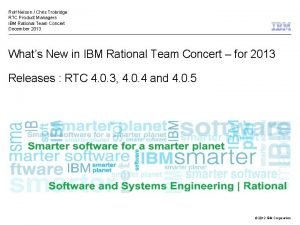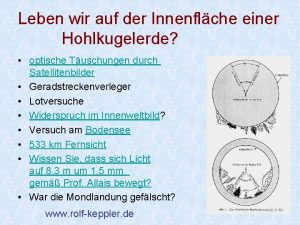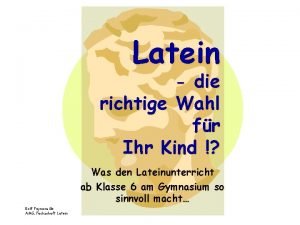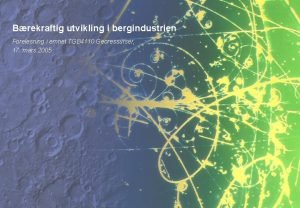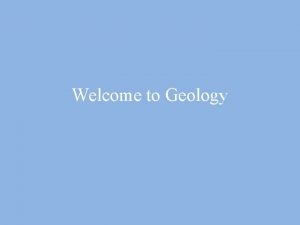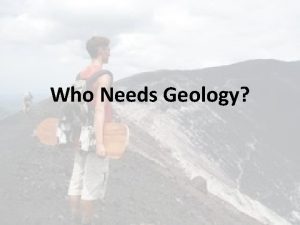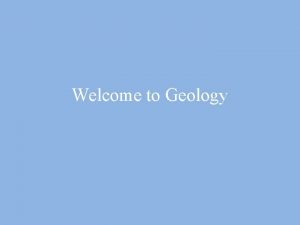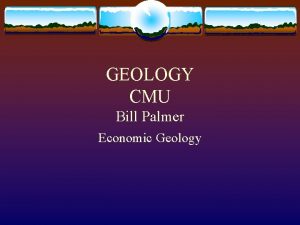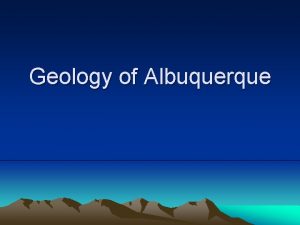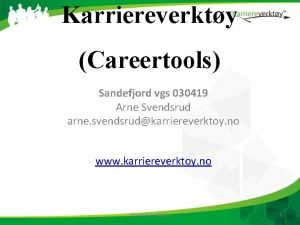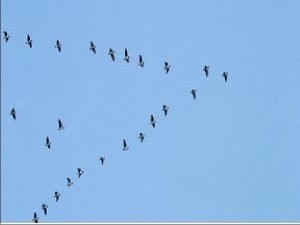Dr Rolf Arne Kleiv Deptartment of Geology and









- Slides: 9

Dr. Rolf Arne Kleiv, Deptartment of Geology and Mineral Resources Engineering, Norwegian University of Science and Technology, Dr. Rolf Arne Kleiv, Deptartment of Geology and Mineral Norwegian- University of Science and Technology, Sem Sælands veg Resources 1, NO-7491 Engineering, Trondheim, Norway rolf. kleiv@geo. ntnu. no Sem Sælands veg 1, NO-7491 Trondheim, Norway - rolf. kleiv@geo. ntnu. no Rolf Arne Kleiv and Maria Thornhill Realistic use of tailings Geonor 2016, Mo i Rana, 16 March 2016

Dr. Rolf Arne Kleiv, Deptartment of Geology and Mineral Resources Engineering, Norwegian University of Science and Technology, Sem Sælands veg 1, NO-7491 Trondheim, Norway - rolf. kleiv@geo. ntnu. no What are tailings? In general, mineral production will yield two types of surplus materials (waste); waste rock from mining and tailings from mineral processing. Feed (Ore) MINING PROCESSING Quarry or underground mine Crushing & milling Separation Waste rock (Surplus/waste) Concentrate (Valuable product) Tailings (Surplus/waste)

Dr. Rolf Arne Kleiv, Deptartment of Geology and Mineral Resources Engineering, Norwegian University of Science and Technology, Sem Sælands veg 1, NO-7491 Trondheim, Norway - rolf. kleiv@geo. ntnu. no Why can’t the mining companies sell the tailings? § The volumes of tailings are often far in excess of market demands. Even large bulk applications become oversaturated. § The tailings are not pure mineral concentrates. Further processing (mineral separation) is often required to satisfy the specifications of potential customers. § The process that produced the tailings may pose restrictions on both direct use or further processing (size distribution, use of process chemicals). § Unless the tailings contain rare minerals or have extraordinary qualities, the competition is huge. (’All’ tailings contain quartz and feldspar). § Many potential applications can be classified as low price commodities. Hence, location and logistics becomes critical. Handling and transport cost represent a major limitation.

Dr. Rolf Arne Kleiv, Deptartment of Geology and Mineral Resources Engineering, Norwegian University of Science and Technology, Sem Sælands veg 1, NO-7491 Trondheim, Norway - rolf. kleiv@geo. ntnu. no How much tailings do we produce? Lifetime consumption of mineral commodities (USA 2015) Lead 400 kg Zinc 250 kg Iron ore 11 800 kg 2400 kg Tailings 45 000 kg Rock, gravel and sand 567 000 kg Cement 22 000 kg Clay 5200 kg Bauxite Gold 50 g Copper 450 kg Other minerals 24 600 kg Salts 15 100 kg Phosphate minerals Other metals 800 kg 7600 kg Source: The Society for Mining, Metallurgy and Exploration Foundation

Dr. Rolf Arne Kleiv, Deptartment of Geology and Mineral Resources Engineering, Norwegian University of Science and Technology, Sem Sælands veg 1, NO-7491 Trondheim, Norway - rolf. kleiv@geo. ntnu. no Is recycling the solution? Fraction of consumption that is being covered by recycling 29 Cu 82 Pb Kilde: UNEP, Global Metals Flow Working Group

Dr. Rolf Arne Kleiv, Deptartment of Geology and Mineral Resources Engineering, Norwegian University of Science and Technology, Sem Sælands veg 1, NO-7491 Trondheim, Norway - rolf. kleiv@geo. ntnu. no How much copper do we need? 18 000 World population (millions) 16 000 14 000 Annual copper production (1000 tonnes) Annual per capita consumption (g/person) 12 000 10 000 8 000 USA and Western Europe annually use ca. 10 kg pr capita, whereas India uses ca. 0, 5 kg per capita. 6 000 4 000 2 000 1920 1940 1960 1980 2000

Dr. Rolf Arne Kleiv, Deptartment of Geology and Mineral Resources Engineering, Norwegian University of Science and Technology, Sem Sælands veg 1, NO-7491 Trondheim, Norway - rolf. kleiv@geo. ntnu. no Use of tailings – positive and negative effects Potential positive effects Potential negative effects § § § § Increased processing costs § Increased consumption of energy Economic profit Reduced need for new mining Reduced need for transportation Reduced deposition costs Reduced need for new deposits Tailings improvement Reduced environmental impact from depositing and chemicals § Remaining (reprocessed) tailings could be less environment friendly. § Loss of quality in products § Increased need for transportation The net effect is not always positive. We should aim for optimal use of the mineral resources (including tailings). Demanding 100% utilisation for new deposits is counterproductive and not the optimal environmental solution. Cost/benefit-analyses should be performed.

Dr. Rolf Arne Kleiv, Deptartment of Geology and Mineral Resources Engineering, Norwegian University of Science and Technology, Sem Sælands veg 1, NO-7491 Trondheim, Norway - rolf. kleiv@geo. ntnu. no Further work… At NTNU, we would like to address the following questions: § What have we learned so far from working towards increased utilisation of mineral resources, nationally and internationally? § How, and to what extent, do governments encourage increased use of tailings? § How, and to what extent, do governments place restrictions on deposition or use of tailings? § What has been done with respect to cost/benefit-analysis on use of tailings? § How should we evaluate the use of tailings against tailings improvement or tailings deposition?

Dr. Rolf Arne Kleiv, Deptartment of Geology and Mineral Resources Engineering, Norwegian University of Science and Technology, Sem Sælands veg 1, NO-7491 Trondheim, Norway - rolf. kleiv@geo. ntnu. no Thank you for your attention Photo: NTNU Info
